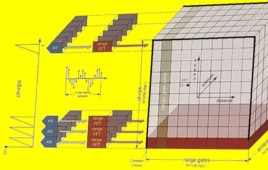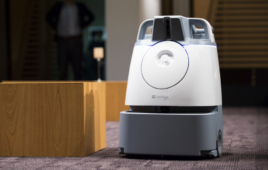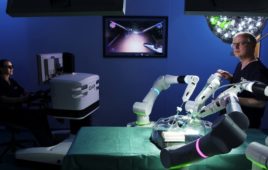 This robot doesn’t look like anything you’ve seen in the factory, nor in a sci-fi flick: It’s a caterpillar-sized assembly of metal rings and strips that looks like something you might find buried in a home-workshop drawer. But the technology behind it, and the long-range possibilities it represents, are remarkable.
This robot doesn’t look like anything you’ve seen in the factory, nor in a sci-fi flick: It’s a caterpillar-sized assembly of metal rings and strips that looks like something you might find buried in a home-workshop drawer. But the technology behind it, and the long-range possibilities it represents, are remarkable.
This small device is called a milli-motein—a name melding its millimeter-sized components and a motorized design inspired by proteins, which naturally fold themselves into extremely complex shapes. This tiny robot may be a harbinger of future devices that could fold themselves up into almost any shape imaginable.
The device was conceived by Neil Gershenfeld, head of MIT’s Center for Bits and Atoms, and graduate students Ara Knaian and Kenneth Cheung.
“It’s effectively a one-dimensional robot that can be made in a continuous strip, without conventionally moving parts, and then folded into arbitrary shapes,” said Gershenfeld.
To build the world’s smallest chain robot, the team had to invent an entirely new kind of motor—one that was small and strong, and also able to hold its position firmly even with power switched off. The researchers solved these issues with a new system called an electropermanent motor.
The motor is similar in principle to the giant electromagnets used in scrapyards to lift cars, in which a powerful permanent magnet is paired with a weaker switchable magnet. The two magnets’ fields either add or cancel, depending on which way the switchable field points. Thus, the force of the powerful magnet can be turned off at will—such as to release a suspended car—without having to power an enormous electromagnet the whole time.
In this new miniature version, a series of permanent magnets paired with electromagnets are arranged in a circle; they drive a steel ring that’s situated around them. The key innovation, Knaian explains, is that “they do not take power in either the on or the off state, but only use power in the changing state,” using minimal energy overall.
The milli-motein concept follows up on a paper that examined the theoretical possibility of assembling any desired 3-D shape simply by folding a long string of identical subunits. That paper, co-authored by Cheung, MIT professor Erik Demaine, alumnus Saul Griffith, and research scientist Jonathan Bachrach, proved mathematically that it was possible for any 3-D shape to be reproduced by folding a sufficiently long string.
“We showed that you could make such a universal system that’s very simple,” Cheung says. While he and his colleagues have not yet proved a way of always finding the optimal path to a given folded shape, they did find several useful strategies for arriving at practical folding sequences.
Other researchers have explored the idea of fashioning reconfigurable robots from a batch of separate pieces that could self-assemble into different configurations, an approach sometimes called “programmable pebbles.” But Gershenfeld’s team found that a string of subunits capable of folding itself into any shape could be simpler in terms of control, power and communications than using separate pieces that must find each other and assemble in the right order. “You can just pass signals down the chain,” Knaian says.
It’s part of an overall approach of “turning data into things.” The milli-motein is part of a family of devices being explored at size scales ranging from protein-based “nanoassemblers” to a version where the chain is as big as a person. The work could lead to robotic systems that can be dynamically reconfigured to do many different jobs rather than repeating a fixed function, and that can be produced much more cheaply than conventional robotics.
Center for Bits and Atoms
cba.mit.edu
Filed Under: The Robot Report





Tell Us What You Think!